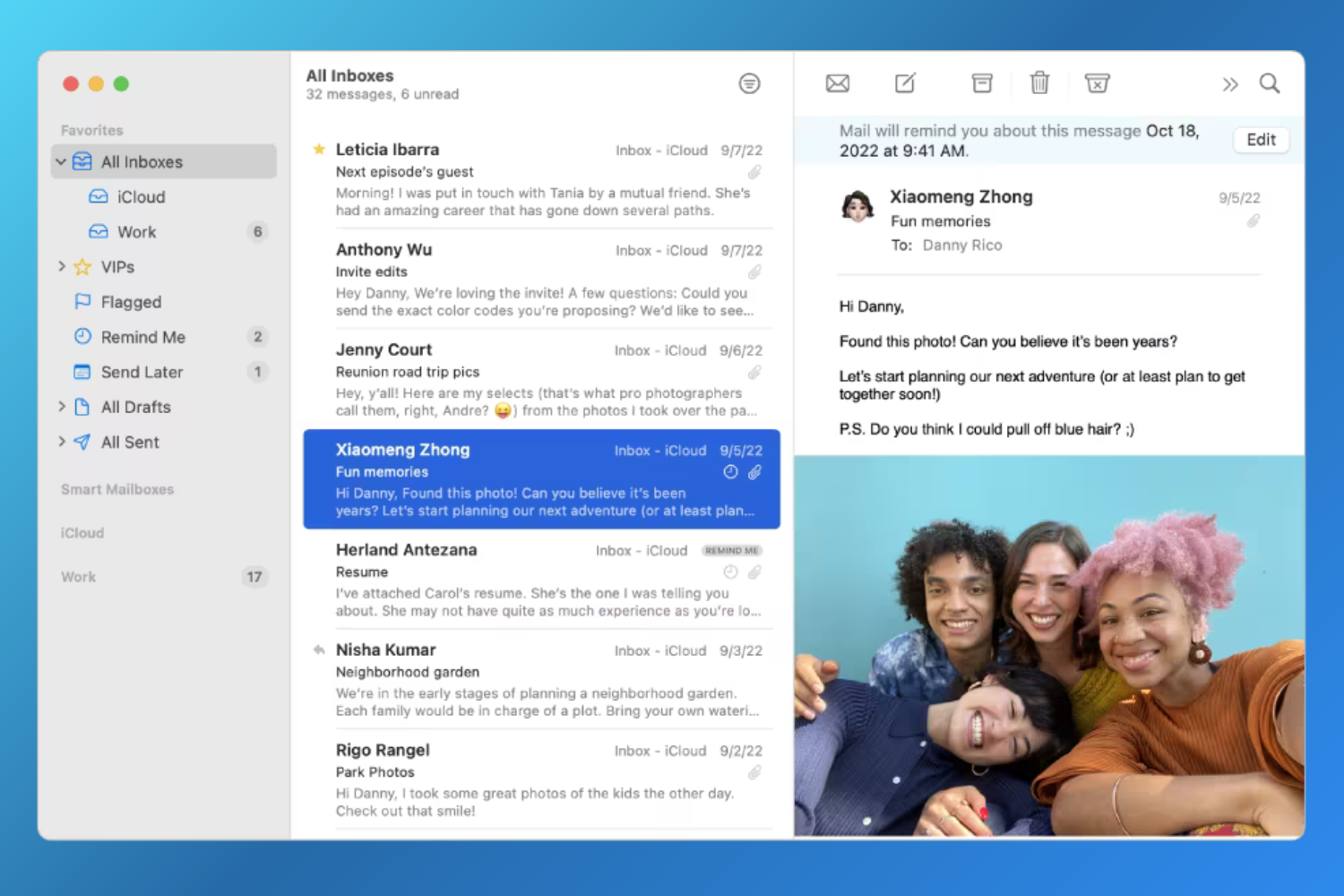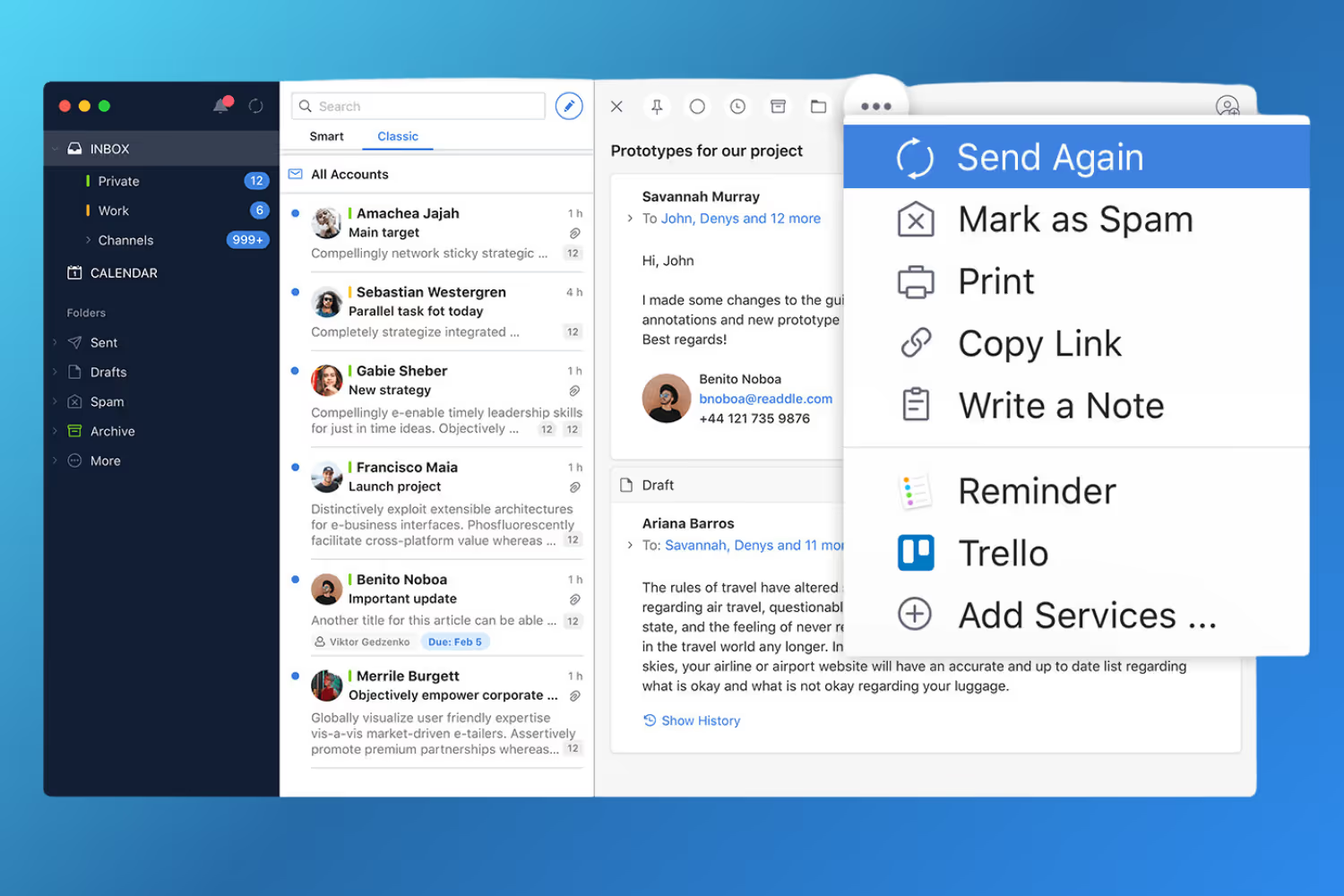If you’re reading this article, you’re likely trying to decide whether to choose Apple Mail or Spark as your primary email client. You may already be using one of these two email providers and wondering whether switching to the other is the right move for you.
Choosing between Apple Mail and Spark comes down to understanding the unique proposition of each of these email clients and how it aligns with your needs. There are a few key differences between Apple Mail and Spark that you should be aware of.
In this article, we make a quick yet detailed comparison between these two email clients to help you make an informed decision.
[cta-block:ctablock3,title="Try smarter email: compare app features",subtitle="Inbox, rules, send safety, AI, privacy.",button1="See Canary Mail",button1link="https://canarymail.io/downloads",button2="Best multi-account apps",button2link="https://canarymail.io/blog/best-email-app-multiple-accounts"]
Spark vs. Apple Mail: Quick Comparison
Instead of going through a lengthy comparison, let’s go straight to the point. Which email client is better? Is it Apple Mail or Spark? Which one should you choose?
While both Apple Mail and Spark work seamlessly on Apple devices, there are quite a few significant differences between them. Many users also consider an Apple Mail vs Gmail comparison when evaluating their options. For starters, Spark focuses on email productivity and a collaborative experience, while Apple Mail focuses on syncing across all Apple devices and apps, like iCloud, Calendar, Contacts, and Notes.
Here are the main differences between Apple Mail and Spark in various categories.

🛠️ Apple Mail vs. Spark: Features
Unlike Spark, Apple Mail is Apple's native email app that integrates seamlessly across all Apple devices and apps. However, many Mac users explore Apple Mail alternatives for enhanced functionality and features. If you’re using the Apple ecosystem, from iCloud to Calendars and Notes on various macOS and iOS devices, Apple Mail is a great choice.
On the other hand, Spark isn’t only designed for Mac. While it does work well on macOS and iOS, it doesn’t integrate as seamlessly with the Apple ecosystem as Apple Mail.
What’s more, Spark’s core focus is email productivity and collaboration. It offers several modern features for a smart email experience that Apple Mail lacks, such as an AI-powered email assistant and a smart inbox.
Here are Apple Mail’s main features:
- Undo send
- Scheduling emails
- Email reminders
- Add multiple email accounts
- Advanced search functionality
- Spam filtering
- Hide your email address
- Change fonts and formatting
Here are some of Spark’s main features for a quick comparison:
- Smart inbox
- AI-powered email assistant
- A unified inbox for multiple email accounts
- Smart search
- Accept or block incoming email accounts
- Group by sender
- Done marker for completed emails
- Mute threads
- Snooze emails
- Follow-up reminders
Overall, Spark offers more advanced and extensive email organization and team collaboration features for a smart email experience that Apple Mail lacks.
🏆 Verdict: Spark takes the crown in terms of features
[cta-block:ctablock2,title="Choose the client that works for you",button1="Download Canary Mail",button1link="https://canarymail.io/downloads",button2="Read Apple Mail alternatives",button2link="https://canarymail.io/blog/apple-mail-alternatives"]
👤 Apple Mail vs. Spark: User Experience
While Apple Mail offers a sleek, modern design that Apple users will find familiar and coherent with the rest of Apple’s apps, Spark provides a more traditional interface that caters to users who value aesthetics combined with efficient email management.
Both Apple Mail and Spark offer an intuitive interface that even first-time users find easy to navigate. What’s more, Spark has a more collaborative nature than Apple Mail. While Apple Mail’s user interface is designed for individuals, Spark’s is directed towards teams.
🏆 Verdict: It’s a tie. Both Apple Mail and Spark offer a great user experience.
🧠 Apple Mail vs. Spark: AI Capabilities
Being a modern email client, Spark comes with integrated AI capabilities, such as an AI-powered email assistant that allows users to write emails with AI and summarize long emails for quicker review. What's more, Spark comes with AI templates for different types of emails. For those prioritizing AI capabilities, this comprehensive guide to the best AI email assistant options can help inform your decision.
Spark's AI algorithms also filter notifications, ensuring users only get alerted of important emails to reduce distractions and enhance productivity. These smart features align with modern unified inbox approaches to email management. In addition to that, Spark's smart inbox categorizes emails based on importance, ensuring priority emails are easily accessible. For those considering other options, exploring Spark alternatives can provide additional insights into email management approaches, ensuring priority emails are easily accessible.
In contrast, Apple Mail doesn’t come with an AI email writer, but it does offer an AI-driven search functionality that predicts user needs and speeds up the email search process. This ensures users find what they're looking for with minimal effort.
🏆 Verdict: Spark takes the crown in terms of AI capabilities.
🔓 Apple Mail vs. Spark: Privacy
Apple Mail offers standard security features like spam and phishing protection. What’s more, it provides users with the option to hide their email so they can send and receive emails without sharing their real address.
Spark puts a strong emphasis on email privacy with more advanced security features like end-to-end encryption, ensuring that all of your emails remain private. Spark also provides robust security but focuses more on server-side encryption and spam filters.
Overall, Apple Mail stores and encrypts your data through their own servers, while Spark’s Spark data storage and encryption are secured through Google Cloud service.
🏆 Verdict: It’s a tie. Both Apple Mail and Spark offer strong email privacy.
💰 Apple Mail vs. Spark: Pricing
Apple Mail is free to use on any macOS or iOS device. Spark is a paid service, but it offers a free plan for personal use with limited features. Its pricing plans start at $4.99 per month, billed annually.
🏆 Verdict: Apple Mail takes the crown in terms of pricing.

Spark Mail vs. Apple Mail: Comparison Summary
FeaturesApple MailSparkAINo AI email writer, it offers an AI-driven search functionality that predicts user needs and speeds up the email search processAI-powered email assistant that allows users to write emails with AI and summarize long emails for quicker reviewUser ExperienceSleek, modern design that Apple users will find familiar and coherent with the rest of Apple’s appsTraditional interface that caters to users who value aesthetics combined with efficient email management. PrivacyIt offers standard security features like spam and phishing protectionProvides robust security but focuses more on server-side encryption and spam filtersPricingfree to use on any macOS or iOS deviceIt offers a free plan for personal use with limited features. Its pricing plans start at $4.99 per month
Spark Email vs. Apple Mail: The Final Verdict
In summary, both Apple Mail and Spark offer a great user experience and some handy features. Your choice between the two will likely depend on your specific needs.
If you’re deeply embedded in the Apple ecosystem and want an email client that will sync across all your Apple devices seamlessly, Apple Mail will be a better choice. However, if you’re looking for more email management features and a smart and collaborative email experience for your team, Spark will be the best option for you.
In the end, the choice between Apple Mail and Spark boils down to individual needs and preferences. For users seeking advanced security features and cross-platform compatibility, Canary Mail offers another compelling option to consider. Both email clients offer features designed to enhance user experience and productivity. The key is to identify which one aligns best with your specific requirements. Ready to explore a secure, AI-powered email experience? Download Canary Mail to discover advanced email management features.
[cta-block:ctablock1,title="One inbox for all accounts. Get started today",button="Install free",buttonlink="https://canarymail.io/downloads"]
Apple Mail vs. Spark: The FAQs
Which is better for multiple inboxes: Apple Mail or Spark?
Spark tends to pull ahead thanks to deeper rule logic, smart scheduling, snooze, and prioritization, making multi-account workflows smoother. If you want more options, see our guide to the best email apps for multiple accounts.
Does Apple Mail support Undo Send or scheduling?
It does, but with limited flexibility and configuration compared to third-party clients like Spark. To explore safer sending, check our article on how to delete an email you sent.
Is Spark safe regarding privacy and data handling?
Spark uses server mediation for many features. If privacy is crucial, prefer clients with local processing, tracker blocking, and minimal external dependencies. For more context, see our Apple Mail alternatives guide.
Can Spark and Apple Mail share data or workflow?
Yes—your accounts, signatures, and rules can often be duplicated manually or via import/export. But shared draft or collaboration features in Spark don’t translate to Apple Mail. To learn more about workflows, visit our email read receipts guide.
How should I measure which email client is better for me?
Track clicks, reply rate, time saved, and adoption for workflows—don’t rely on open rates. For a deeper look into engagement metrics, check out our guide on email read receipts.